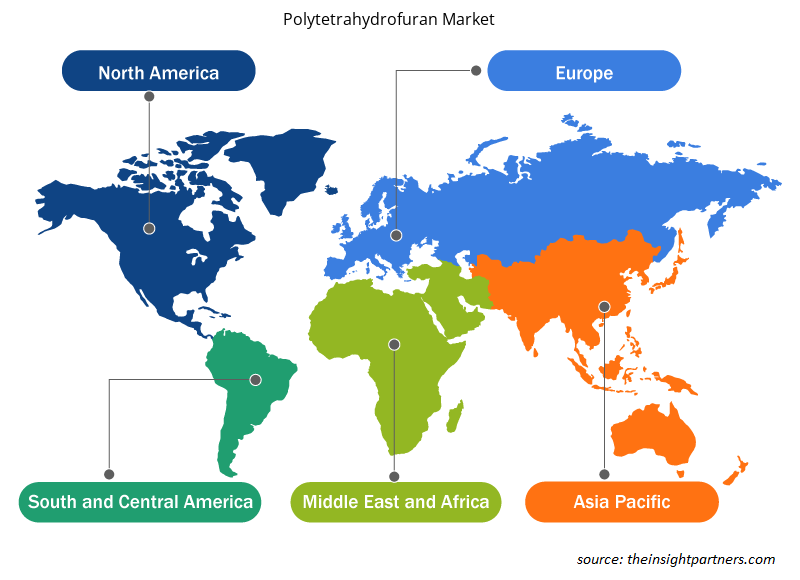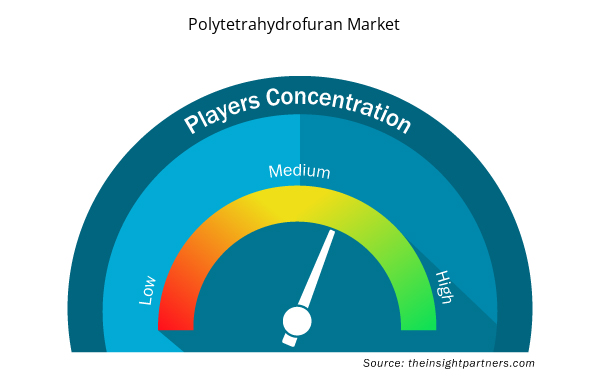ポリテトラヒドロフラン市場は、2024年から2031年にかけて6%のCAGRを記録し、市場規模は2024年のXX百万米ドルから2031年にはXX百万米ドルに拡大すると予想されています。
ポリテトラヒドロフラン市場レポートは、形態(液体および固体)別にセグメント化されています。市場は、タイプ(石油ベースおよびバイオベース)に基づいてセグメント化されています。市場は、用途(熱可塑性ポリウレタン、スパンデックス繊維、コポリエステルエーテルエラストマーなど)に基づいてセグメント化されています。市場は、最終用途(塗料およびコーティング、繊維、接着剤およびシーラント、人工皮革など)に基づいてセグメント化されています。すべての主要な市場セグメントの市場規模と予測は、スコープ内に含まれています。レポートでは、上記の分析、セグメント、地域、国について、USD での値を提供しています。レポートでは、市場動向だけでなく、推進要因、制約、主要な機会などの市場動向も取り上げています。レポートでは、市場集中、ヒートマップ分析、主要なプレーヤー、および市場の最近の動向を含む業界の状況と競争分析も取り上げています。
報告書の目的
The Insight Partners によるポリテトラヒドロフラン市場レポートは、現在の状況と将来の成長、主な推進要因、課題、機会を説明することを目的としています。これにより、次のようなさまざまなビジネス関係者に洞察が提供されます。
- テクノロジープロバイダー/メーカー: 進化する市場の動向を理解し、潜在的な成長機会を把握することで、情報に基づいた戦略的意思決定が可能になります。
- 投資家: 市場の成長率、市場の財務予測、バリュー チェーン全体に存在する機会に関する包括的な傾向分析を実施します。
- 規制機関: 市場の濫用を最小限に抑え、投資家の信用と信頼を維持し、市場の完全性と安定性を維持することを目的として、市場における政策と警察活動を規制します。
ポリテトラヒドロフラン市場のセグメンテーション
形状
- 液体と固体
タイプ
- 石油由来とバイオ由来
応用
- 熱可塑性ポリウレタン
- スパンデックス繊維
- コポリエステルエーテルエラストマー
地理
- 北米
- ヨーロッパ
- アジア太平洋
- 南米と中央アメリカ
- 中東およびアフリカ
要件に合わせてレポートをカスタマイズする
このレポートの一部、国レベルの分析、Excelデータパックなど、あらゆるレポートを無料でカスタマイズできます。また、スタートアップや大学向けのお得なオファーや割引もご利用いただけます。
- このレポートの主要な市場動向を入手してください。この無料サンプルには、市場動向から見積もりや予測に至るまでのデータ分析が含まれます。
ポリテトラヒドロフラン市場の成長要因
- アクティブウェアやスポーツウェア向けの伸縮性生地の需要増加: ポリテトラヒドロフラン (PTMEG) は、主にスパンデックス繊維を含むポリウレタン エラストマーの製造に欠かせない原料です。これは合成繊維に変換可能な繊維で、主にアクティブウェア、スポーツウェア、またはファッショナブルなスタイルで着用されるような、伸縮性に優れた肌にぴったりフィットする衣類の製造に使用されます。用途は、衣料品業界での伸縮性、快適性、高性能生地の需要増加に重点が置かれる傾向があり、そのため PTMEG が消費されています。したがって、フィットネスとパフォーマンスの両方で伸縮性と耐久性に優れた素材の品質が向上したことで、不可欠な重要な部分を形成する基本成分としての PTMEG のこの分野の成長が促進されています。Activewear and Sportswear: Polytetrahydrofuran, commonly known as PTMEG, is a key raw material for the production of polyurethane elastomers that mostly include spandex fibers. It is convertible fibers into a man-made textile that is primarily used in the manufacturing of highly stretchable skin-tight garments, such as those worn in activewear, sportswear, or in fashionable styles. Applications tend to focus on the increased demand for stretchy, comfortable, high-performance fabrics in the clothing industry - hence PTMEG is consumed. Thus, advancement in such stretchable as well as durable materials qualities for both fitness and performance has been fuelling growth in that section of PTMEG as a basic ingredient which forms an integral-critical part.
- 自動車および建設部門における PTMEG の役割の拡大: したがって、PTMEG のこの発展は、自動車および建設部門の急増と並行しています。自動車生産では、ポリウレタンは座席、断熱材、クッション材として使用されています。同様に、このポリマーは、建設業界ではコーティング、シーラント、断熱材に使用されています。使用される PTMEG の大部分は、高性能ポリウレタンの主なリソースであり、柔軟性がありながら、業界の需要に容易に対応できるため、耐久性と環境ストレスに対する耐性が実証されています。したがって、自動車および建設部門の成長に伴い、ポリウレタンの基本生産の前駆体である PTMEG の必要性も高まります。
- 高性能ポリウレタンの需要の高まり: これは、PTMEG を支えるもう 1 つの強力な力です。PTMEG から得られるポリウレタンはさまざまな用途に使用されており、高い接着強度、柔軟性、および研磨剤や環境要因に対する優れた耐性という利点があるため、この分野で最も多く使用されています。ポリウレタンの高度に特殊化された用途は、自動車、航空宇宙、建設、または消費財など、ほぼすべての業界の接着剤やコーティングに使用されています。これらの業界が世界中で拡大していること、および高性能接着剤やコーティングが好まれていることが、PTMEG の需要増加を後押ししています。
ポリテトラヒドロフラン市場の将来動向
- バイオベース PTMEG の需要の高まり: バイオベース PTMEG の生産は、ますます多くの環境保護主義者が業界内で持続可能性に関心を持ち始めているため、本当に話題になっています。植物ベースの原料などの再生可能な原材料から得られるこのバイオベースの PTMEG は、従来の石油化学製品と比較して環境への影響が少ないため、人気が高まると予想されています。持続可能性に向けたこの取り組みは、特に自動車業界と繊維業界から、より環境に優しい化学物質と材料を世界に供給するために、より持続可能な生産チェーンを開発するという段階的な動きに反映されています。企業と業界が持続可能性の要件を満たすにつれて、最終的には用途の増加が見られるでしょう。
- 高性能ポリウレタンの需要の高まり: 高性能ポリウレタンは、PTMEG 市場に関連するトレンドの 1 つです。これらのポリウレタンは、通常、航空宇宙、医療機器、一部の高性能自動車部品など、要求の厳しいアプリケーション セクターで使用され、PTMEG には、より高い弾力性、耐久性、耐熱性、耐薬品性などの特定の特性が必要です。産業界は、非常に長持ちするコンポーネントや部品を生み出し、エネルギーを最大限に活用する先進的な材料を求めているため、このような特性は PTMEG に大きな期待が寄せられています。ポリウレタン化学の革新とカスタマイズされた PTMEG が、開発を促進すると予想されます。
- 3D 印刷と積層製造における PTMEG の役割: PTMEG 市場で成長しているもう 1 つのトレンドは、3D 印刷と積層製造における PTMEG の使用です。3D パーツでは、柔軟性、強度、耐久性に優れた PTMEG ベースのものを含むポリウレタンベースの材料がますます使用されています。3D 印刷が自動車、ヘルスケア、消費者製品の分野で特に普及し続けるにつれて、3D 印刷に移行するアプリケーションでの PTMEG の需要は高まるばかりです。より広範な積層型製造の枠組みの中で、高性能材料から派生した複雑な形状の製造に関しては、PTMEG の将来は非常に明るいものになります。
ポリテトラヒドロフラン市場の機会
- 医療機器の革新における PTMEG の役割: 医療分野、特に医療グレードのポリウレタン製造には PTMEG の大きなチャンスがあります。こうした材料は、生体適合性と柔軟性だけでなく耐久性も備えているため、カテーテル、創傷被覆材、インプラント装置など、多くの医療分野で使用されています。世界中で医療サービスの需要が高まり、医療機器の設計が継続的に改善されているため、PTMEG の条件は、高度な医療材料開発における重要性の高まりに非常に適したものになっています。医療グレードのポリウレタンは、より多用途で高性能な材料を求める医療分野からの需要が増加する傾向にあります。
- 新興市場が PTMEG 需要を促進: PTMEG の市場を形成する国は、新興のアジア、ラテンアメリカ、アフリカの市場です。これらの市場は、急速な工業化と都市化のプロセスの主な要因であり、その結果、特に自動車および繊維部門でポリウレタンの需要が高まっています。これらの国では、可処分所得の増加とインフラの改善により中流階級の人口が増加しており、スパンデックス繊維、断熱材、さまざまな自動車部品における PTMEG の需要が増加すると予想されています。企業は、成長を続けるこれらの経済で製造および流通ネットワークの拡大を検討する必要があります。
- 電気自動車が PTMEG 需要を牽引: 電気自動車の需要が急増したため、自動車分野では PTMEG の需要が高まっています。PTMEG ベースのポリウレタンが断熱材、座席、車内部品に使用されるという理論は、電気自動車に特に当てはまります。最も重要なのは、電気自動車自体などの一般的なアイテムの軽量化が期待されることです。ほとんどのメーカーがエネルギー使用の範囲と効率の改善に取り組んでいるため、ポリウレタンの軽量特性は需要の増加を予期しています。PTMEG ベースのコンポーネントは、電気自動車用のより耐久性が高く環境に優しいコンポーネントの製造に貢献すると考えられています。したがって、今後数年間にいくつかの成長機会が生まれる可能性は高いです。
ポリテトラヒドロフラン市場の地域別分析
予測期間を通じてポリテトラヒドロフラン市場に影響を与える地域的な傾向と要因は、Insight Partners のアナリストによって徹底的に説明されています。このセクションでは、北米、ヨーロッパ、アジア太平洋、中東およびアフリカ、南米および中米にわたるポリテトラヒドロフラン市場のセグメントと地理についても説明します。

- ポリテトラヒドロフラン市場の地域別データを入手
ポリテトラヒドロフラン市場レポートの範囲
| レポート属性 | 詳細 |
|---|---|
| 2024年の市場規模 | XX百万米ドル |
| 2031年までの市場規模 | XX百万米ドル |
| 世界のCAGR(2025年~2031年) | 6% |
| 履歴データ | 2021-2023 |
| 予測期間 | 2025-2031 |
| 対象セグメント | フォーム別
|
| 対象地域と国 | 北米
|
| 市場リーダーと主要企業プロフィール |
|
ポリテトラヒドロフラン市場のプレーヤー密度:ビジネスダイナミクスへの影響を理解する
ポリテトラヒドロフラン市場は、消費者の嗜好の変化、技術の進歩、製品の利点に対する認識の高まりなどの要因により、エンドユーザーの需要が高まり、急速に成長しています。需要が高まるにつれて、企業は提供品を拡大し、消費者のニーズを満たすために革新し、新たなトレンドを活用し、市場の成長をさらに促進しています。
市場プレーヤー密度とは、特定の市場または業界内で活動している企業または会社の分布を指します。これは、特定の市場スペースに、その市場規模または総市場価値に対してどれだけの競合相手 (市場プレーヤー) が存在するかを示します。
ポリテトラヒドロフラン市場で事業を展開している主要企業は次のとおりです。
- BASF SE
- ダイレンケミカル株式会社(DCC)
- 三菱ケミカル
- アッシュランド株式会社
- 韓国PT株式会社
免責事項:上記の企業は、特定の順序でランク付けされていません。

- ポリテトラヒドロフラン市場のトップキープレーヤーの概要を入手
主なセールスポイント
- 包括的なカバレッジ: レポートでは、ポリテトラヒドロフラン市場の製品、サービス、タイプ、エンドユーザーの分析を包括的にカバーし、全体的な展望を提供します。
- 専門家による分析: レポートは、業界の専門家とアナリストの深い理解に基づいてまとめられています。
- 最新情報: このレポートは、最新の情報とデータの傾向を網羅しているため、ビジネスの関連性を保証します。
- カスタマイズ オプション: このレポートは、特定のクライアント要件に対応し、ビジネス戦略に適切に適合するようにカスタマイズできます。
したがって、ポリテトラヒドロフラン市場に関する調査レポートは、業界のシナリオと成長の見通しを解読し理解する道の先導役となることができます。いくつかの正当な懸念があるかもしれませんが、このレポートの全体的な利点は欠点を上回る傾向があります。
- 過去2年間の分析、基準年、CAGRによる予測(7年間)
- PEST分析とSWOT分析
- 市場規模価値/数量 - 世界、地域、国
- 業界と競争環境
- Excel データセット


- Flexible Garden Hoses Market
- Artificial Intelligence in Defense Market
- HVAC Sensors Market
- Equipment Rental Software Market
- Hair Extensions Market
- Sleep Apnea Diagnostics Market
- Medical Enzyme Technology Market
- Mail Order Pharmacy Market
- Skin Tightening Market
- Advanced Planning and Scheduling Software Market

Report Coverage
Revenue forecast, Company Analysis, Industry landscape, Growth factors, and Trends

Segment Covered
This text is related
to segments covered.

Regional Scope
North America, Europe, Asia Pacific, Middle East & Africa, South & Central America

Country Scope
This text is related
to country scope.
よくある質問
Sustainability and bio-based PTMEG production are expected to be the key market trends.
Based on geography, Asia Pacific held the largest share of the polytetrahydrofuran market due to the strong growth of the construction industry in the region.
Based on end use, the paints and coatings segment is expected to witness the fastest growth during the forecast period.
Rising demand in the production of spandex and polyurethane are driving the market growth.
BASF SE, Dairen Chemical Corp, Mitsubishi Chemical Holdings, Hyosung Chemical, Muby Chemicals, Merck KGaA, Ashland Inc, Arpadis, Formosa Asahi Spandex, and Shanxi Sanwei Group are the key players operating in the polytetrahydrofuran market.
The Polytetrahydrofuran Market is estimated to witness a CAGR of 6% from 2023 to 2031
Trends and growth analysis reports related to Chemicals and Materials : READ MORE..
1.BASF SE
2.DairenChemicalCorporation(DCC)
3.Mitsubishi Chemicals
4.Ashland Inc.
5.Korea PT Co., Ltd.
6.Shanxi Sanwei Group Co., Ltd.
7.Formosa Asahi Spandex
8.Hyosung Chemical Fiber
9.Sanlong New Materials
The Insight Partners performs research in 4 major stages: Data Collection & Secondary Research, Primary Research, Data Analysis and Data Triangulation & Final Review.
- Data Collection and Secondary Research:
As a market research and consulting firm operating from a decade, we have published and advised several client across the globe. First step for any study will start with an assessment of currently available data and insights from existing reports. Further, historical and current market information is collected from Investor Presentations, Annual Reports, SEC Filings, etc., and other information related to company’s performance and market positioning are gathered from Paid Databases (Factiva, Hoovers, and Reuters) and various other publications available in public domain.
Several associations trade associates, technical forums, institutes, societies and organization are accessed to gain technical as well as market related insights through their publications such as research papers, blogs and press releases related to the studies are referred to get cues about the market. Further, white papers, journals, magazines, and other news articles published in last 3 years are scrutinized and analyzed to understand the current market trends.
- Primary Research:
The primarily interview analysis comprise of data obtained from industry participants interview and answers to survey questions gathered by in-house primary team.
For primary research, interviews are conducted with industry experts/CEOs/Marketing Managers/VPs/Subject Matter Experts from both demand and supply side to get a 360-degree view of the market. The primary team conducts several interviews based on the complexity of the markets to understand the various market trends and dynamics which makes research more credible and precise.
A typical research interview fulfils the following functions:
- Provides first-hand information on the market size, market trends, growth trends, competitive landscape, and outlook
- Validates and strengthens in-house secondary research findings
- Develops the analysis team’s expertise and market understanding
Primary research involves email interactions and telephone interviews for each market, category, segment, and sub-segment across geographies. The participants who typically take part in such a process include, but are not limited to:
- Industry participants: VPs, business development managers, market intelligence managers and national sales managers
- Outside experts: Valuation experts, research analysts and key opinion leaders specializing in the electronics and semiconductor industry.
Below is the breakup of our primary respondents by company, designation, and region:

Once we receive the confirmation from primary research sources or primary respondents, we finalize the base year market estimation and forecast the data as per the macroeconomic and microeconomic factors assessed during data collection.
- Data Analysis:
Once data is validated through both secondary as well as primary respondents, we finalize the market estimations by hypothesis formulation and factor analysis at regional and country level.
- Macro-Economic Factor Analysis:
We analyse macroeconomic indicators such the gross domestic product (GDP), increase in the demand for goods and services across industries, technological advancement, regional economic growth, governmental policies, the influence of COVID-19, PEST analysis, and other aspects. This analysis aids in setting benchmarks for various nations/regions and approximating market splits. Additionally, the general trend of the aforementioned components aid in determining the market's development possibilities.
- Country Level Data:
Various factors that are especially aligned to the country are taken into account to determine the market size for a certain area and country, including the presence of vendors, such as headquarters and offices, the country's GDP, demand patterns, and industry growth. To comprehend the market dynamics for the nation, a number of growth variables, inhibitors, application areas, and current market trends are researched. The aforementioned elements aid in determining the country's overall market's growth potential.
- Company Profile:
The “Table of Contents” is formulated by listing and analyzing more than 25 - 30 companies operating in the market ecosystem across geographies. However, we profile only 10 companies as a standard practice in our syndicate reports. These 10 companies comprise leading, emerging, and regional players. Nonetheless, our analysis is not restricted to the 10 listed companies, we also analyze other companies present in the market to develop a holistic view and understand the prevailing trends. The “Company Profiles” section in the report covers key facts, business description, products & services, financial information, SWOT analysis, and key developments. The financial information presented is extracted from the annual reports and official documents of the publicly listed companies. Upon collecting the information for the sections of respective companies, we verify them via various primary sources and then compile the data in respective company profiles. The company level information helps us in deriving the base number as well as in forecasting the market size.
- Developing Base Number:
Aggregation of sales statistics (2020-2022) and macro-economic factor, and other secondary and primary research insights are utilized to arrive at base number and related market shares for 2022. The data gaps are identified in this step and relevant market data is analyzed, collected from paid primary interviews or databases. On finalizing the base year market size, forecasts are developed on the basis of macro-economic, industry and market growth factors and company level analysis.
- Data Triangulation and Final Review:
The market findings and base year market size calculations are validated from supply as well as demand side. Demand side validations are based on macro-economic factor analysis and benchmarks for respective regions and countries. In case of supply side validations, revenues of major companies are estimated (in case not available) based on industry benchmark, approximate number of employees, product portfolio, and primary interviews revenues are gathered. Further revenue from target product/service segment is assessed to avoid overshooting of market statistics. In case of heavy deviations between supply and demand side values, all thes steps are repeated to achieve synchronization.
We follow an iterative model, wherein we share our research findings with Subject Matter Experts (SME’s) and Key Opinion Leaders (KOLs) until consensus view of the market is not formulated – this model negates any drastic deviation in the opinions of experts. Only validated and universally acceptable research findings are quoted in our reports.
We have important check points that we use to validate our research findings – which we call – data triangulation, where we validate the information, we generate from secondary sources with primary interviews and then we re-validate with our internal data bases and Subject matter experts. This comprehensive model enables us to deliver high quality, reliable data in shortest possible time.


 このレポートの無料サンプルを入手する
このレポートの無料サンプルを入手する